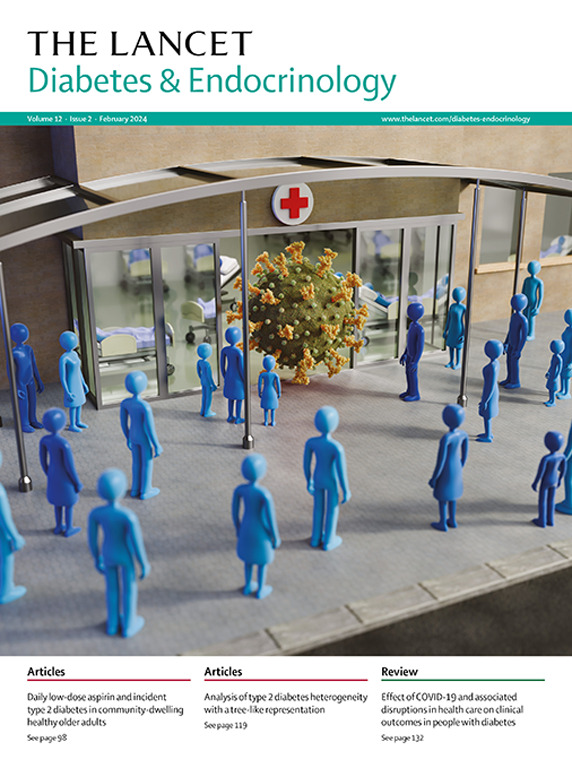Efficacy and safety of a biased GLP-1 receptor agonist ecnoglutide in adults with overweight or obesity: a multicentre, randomised, double-blind, placebo-controlled, phase 3 trial
IF 44
1区 医学
Q1 ENDOCRINOLOGY & METABOLISM
引用次数: 0
Abstract
Background
Ecnoglutide is a novel cyclic adenosine monophosphate (cAMP)-biased GLP-1 receptor agonist currently in development for weight management. We aimed to assess the efficacy and safety of once weekly ecnoglutide versus placebo for the treatment of overweight or obesity in Chinese adults.Methods
This randomised, double-blind, placebo-controlled, phase 3 trial was done at 36 medical centres across China. Eligible adults were aged 18–75 years with overweight or obesity (defined as BMI ≥28 kg/m2 or ≥24 kg/m2 with at least one weight-related comorbidity [prediabetes, hypertension, hyperlipidaemia, metabolic dysfunction-associated steatotic liver disease, obstructive sleep apnoea syndrome, or weight-bearing joint pain]), without diabetes (type 1 or 2). Participants were randomly assigned (3:3:3:1:1:1) via computer-generated random sequencing to receive subcutaneous ecnoglutide (1·2, 1·8, or 2·4 mg) or volume-matched placebo (1·2, 1·8, or 2·4 mg), once weekly, stratified by BMI at screening (≥28 kg/m2 and <28 kg/m2). The coprimary endpoints were percentage change in bodyweight and proportion of participants with a reduction in bodyweight of 5% or more at week 40 (using the treatment policy estimand in the full analysis set). The full analysis set included all randomly assigned participants who were exposed to at least one dose of study drug or placebo according to their assigned treatment group. Safety was assessed in all participants who received at least one dose and had a safety assessment after medication. This study was registered with ClinicalTrials.gov, NCT05813795, and is complete.Findings
Between April 5, 2023, and June 20, 2024, 882 participants were screened and 664 were randomly assigned to receive ecnoglutide 1·2 mg (n=166), ecnoglutide 1·8 mg (n=166), ecnoglutide 2·4 mg (n=167), or placebo (n=165). At week 40, the least-squares mean percentage change in bodyweight was –9·1% (SE 0·8) in the ecnoglutide 1·2 mg group, –10·9% (0·9) in the ecnoglutide 1·8 mg group, and –13·2% (0·8) in the ecnoglutide 2·4 mg group versus 0·1% (0·8) in the placebo group, and the respective estimated treatment differences compared with placebo were –9·2% (97% CI –11·0 to –7·5), –11·1% (–13·1 to –9·1), and –13·3% (–15·3 to –11·3), respectively (all p<0·0001). The proportion of participants who achieved at least a 5% reduction in bodyweight at week 40 was 77% in the ecnoglutide 1·2 mg group, 84% in the ecnoglutide 1·8 mg group, and 87% in the ecnoglutide 2·4 mg group versus 16% of participants in the placebo group, and the respective estimated treatment differences versus placebo were 60% (98% CI 50 to 71), 68% (58 to 78), and 70% (61 to 80; all p<0·0001). Treatment-emergent adverse events were observed in 155 (93%) of 166 participants in the ecnoglutide 1·2 mg group, 154 (93%) of 166 participants in the ecnoglutide 1·8 mg group, 156 (93%) of 167 participants in the ecnoglutide 2·4 mg group, and 139 (84%) of 165 participants in the placebo group. The most common adverse events were mild-to-moderate gastrointestinal related events. Ten participants treated with ecnoglutide discontinued treatment due to adverse events.Interpretation
In adults with obesity or overweight without diabetes (type 1 or 2), individuals administered ecnoglutide had superior and sustained reduction in bodyweight versus placebo with a favourable safety profile, supporting its potential use for weight management.Funding
Hangzhou Sciwind Biosciences.偏置GLP-1受体激动剂ecnoglutide对超重或肥胖成人的疗效和安全性:一项多中心、随机、双盲、安慰剂对照的3期试验
decnoglutide是一种新的环腺苷单磷酸(cAMP)偏倚GLP-1受体激动剂,目前正在开发用于体重管理。我们的目的是评估每周一次ecnoglutide与安慰剂治疗中国成人超重或肥胖的疗效和安全性。这项随机、双盲、安慰剂对照的三期试验在中国36个医疗中心进行。符合条件的成人年龄为18-75岁,体重超重或肥胖(定义为BMI≥28 kg/m2或≥24 kg/m2,伴有至少一种体重相关合并症[糖尿病前期、高血压、高脂血症、代谢功能障碍相关脂肪变性肝病、阻塞性睡眠呼吸暂停综合征或负重关节痛]),无糖尿病(1型或2型)。通过计算机生成的随机测序,参与者被随机分配(3:3:3:1:1:1)接受皮下ecnoglutide(1,2,1,8或2.4 mg)或容量匹配的安慰剂(1,2,1,8或2.4 mg),每周一次,根据筛查时的BMI分层(≥28 kg/m2和≤28 kg/m2)。主要终点是体重变化的百分比和参与者在第40周体重减少5%或更多的比例(使用完整分析集中的治疗政策估计)。完整的分析集包括所有随机分配的参与者,根据他们指定的治疗组,他们至少暴露于一剂研究药物或安慰剂。对所有至少接受一次剂量的参与者进行安全性评估,并在用药后进行安全性评估。本研究已在ClinicalTrials.gov注册,编号NCT05813795,现已完成。在2023年4月5日至2024年6月20日期间,筛选了882名参与者,并随机分配664名参与者接受ecnoglutide 1.2 mg (n=166), ecnoglutide 1.8 mg (n=166), ecnoglutide 2.4 mg (n=167)或安慰剂(n=165)。在第40周,ecnoglutide 1.2 mg组体重的最小二乘平均百分比变化为- 9.1% (SE 0.8), ecnoglutide 1.8 mg组为- 10.9% (SE 0.8), ecnoglutide 2.4 mg组为- 13.2% (SE 0.8),而安慰剂组为0.1%(0.8%),与安慰剂组相比,各自的估计治疗差异分别为- 9.2% (97% CI - 11.0至- 7.5),- 11.1%(- 13.1至- 9.1)和- 13.3%(- 15.3至- 11.3)(所有p<; 0.0001)。在第40周体重减轻至少5%的参与者比例在ecnoglutide 1.2 mg组为77%,在ecnoglutide 1.8 mg组为84%,在ecnoglutide 2.4 mg组为87%,而安慰剂组为16%,与安慰剂组相比,各自的估计治疗差异为60% (98% CI 50至71),68%(58至78)和70%(61至80);所有术;0·0001)。166名受试者中,ecnoglutide 1.2 mg组有155名(93%)出现治疗不良事件,166名受试者中,ecnoglutide 1.8 mg组有154名(93%),167名受试者中,ecnoglutide 2.4 mg组有156名(93%),165名安慰剂组有139名(84%)出现治疗不良事件。最常见的不良事件是轻至中度胃肠道相关事件。10名接受ecnoglutide治疗的参与者因不良事件而停止治疗。在没有糖尿病(1型或2型)的肥胖或超重的成年人中,与安慰剂相比,服用ecnoglutide的个体具有优越的、持续的体重减轻效果,并且具有良好的安全性,支持其在体重管理方面的潜在应用。资助杭州科风生物科技。
本文章由计算机程序翻译,如有差异,请以英文原文为准。
求助全文
约1分钟内获得全文
求助全文
来源期刊

The Lancet Diabetes & Endocrinology
ENDOCRINOLOGY & METABOLISM-
CiteScore
61.50
自引率
1.60%
发文量
371
期刊介绍:
The Lancet Diabetes & Endocrinology, an independent journal with a global perspective and strong clinical focus, features original clinical research, expert reviews, news, and opinion pieces in each monthly issue. Covering topics like diabetes, obesity, nutrition, and more, the journal provides insights into clinical advances and practice-changing research worldwide. It welcomes original research advocating change or shedding light on clinical practice, as well as informative reviews on related topics, especially those with global health importance and relevance to low-income and middle-income countries. The journal publishes various content types, including Articles, Reviews, Comments, Correspondence, Health Policy, and Personal Views, along with Series and Commissions aiming to drive positive change in clinical practice and health policy in diabetes and endocrinology.
 求助内容:
求助内容: 应助结果提醒方式:
应助结果提醒方式:


